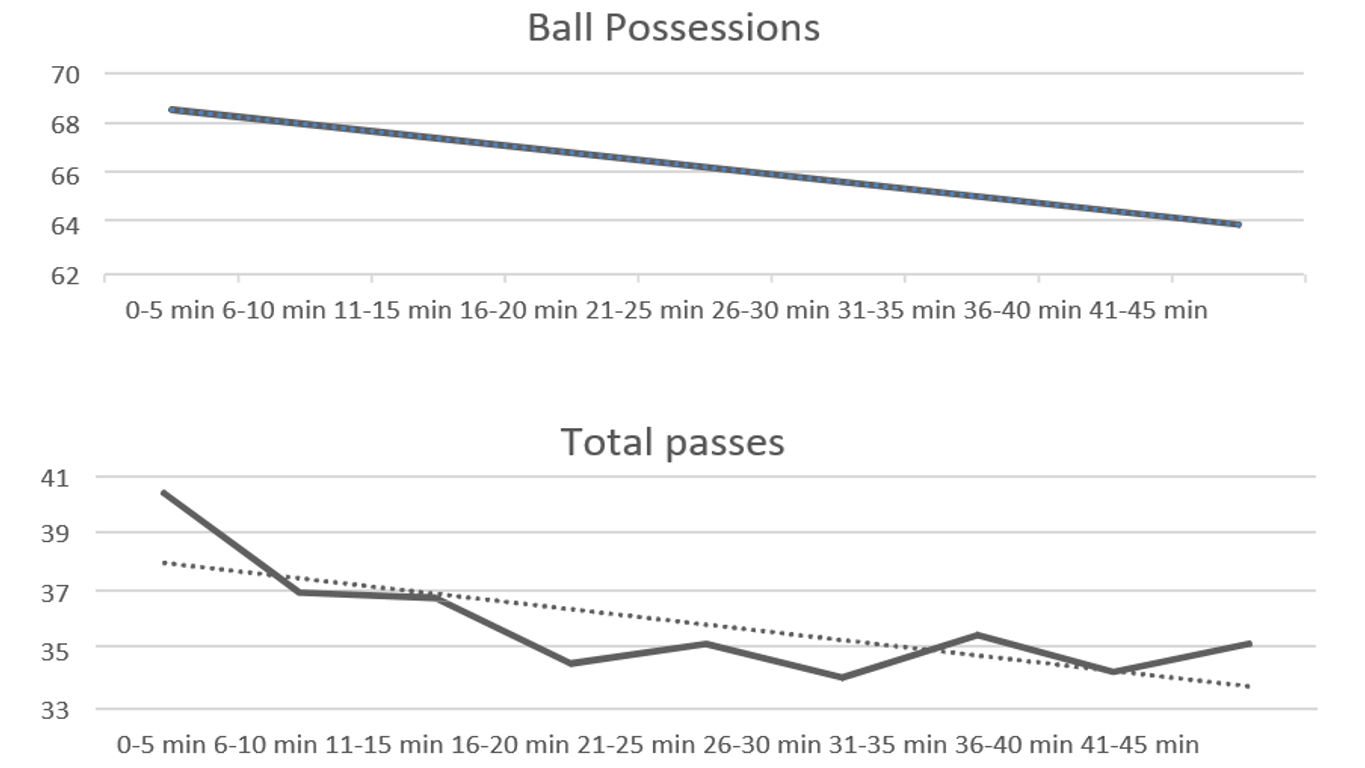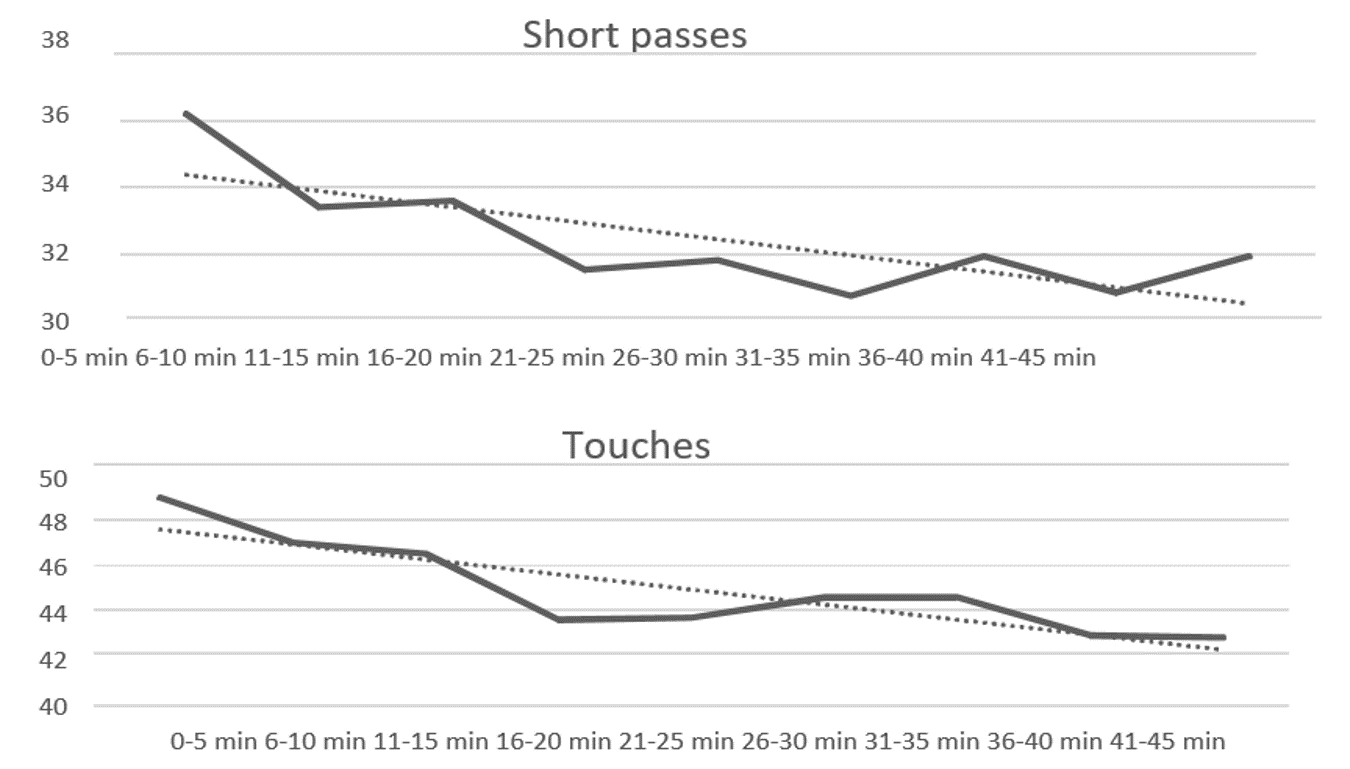The advantage of playing at home in football is a widely studied and recognised phenomenon. It is calculated as a percentage using the points earned by a team at home over the team’s total points for the entire season. A figure of 50% would indicate that there is no such effect since the team would have the same amount of points from home and away. Percentages higher than 50% would highlight the advantage of playing at home, while percentages below 50% would show that the visiting team actually achieves better results. The closer a score gets to 100%, the stronger the effect of the home advantage.
In the “Big Five” European football leagues (Premier League, Bundesliga, Ligue 1, Serie A and La Liga) the home advantage results in an average score of 60.89%, varying between a maximum of 62.25% in Italy’s Serie A and 58.35% in the German Bundesliga.1 Teams score more points when playing in their home stadiums, but we know much more. This effect has been reduced ever since 3 points became the new award for winning a match. In La Liga, for example, home teams went from earning 66.27% to 62.09% of their points at home.2 The advantage of playing at home depends on a given team’s level as well as the strength of their rivals.3 Top teams maintain a more stable performance both at home and away. The further down a club is positioned in the league table, the more important the advantage of playing at home. We also know which specific aspects of the game have the greatest influence on this effect.
The causes that explain the advantage of playing at home4 relate to:
- The crowds’ support
- Travel fatigue
- Familiarity with the home conditions (features of the pitch, the impact of the sun and the wind or the benefits of being in a familiar and friendly atmosphere)
- Territoriality
- The referee’s bias in favouring home teams
- Changing visitor teams tactics in tactics of the visiting teams and
- Other psychological aspects
A recent study5 provided important insight for coaches and performance analysts. The objective of this project consisted of analysing whether the advantage of playing at home remained constant or not throughout the entire match. For this project, researchers analysed 90 matches from the Premier League (n=19), Ligue 1 (n=21), La Liga (n=18), Serie A (n=19) and the Bundesliga (n=19) in which the first half ended 0-0.


The performance of the home teams was measured using 7 variables (ball possession, throw-ins, short passes, long passes, pass success percentage, touches, and defensive aspects (clearances + fouls + recoveries) in 5 minute periods (0-5, 6-10, 11-15, 16-20, 21-25, 26-30, 31-35, 36-40, 41-45). Ball possession (p<0.01), the pass success percentage (p<0.05), short passes (p<0.05) and touches (p<0.01) had the highest values in the 0-5 minute periods compared with the rest of the periods in the match. However, as the game went on, the performance of the home teams became increasingly worse. This trend spiked from the period between 16-20 minutes onwards. This transient effect was reduced or increased depending on the strength of the rival team (p<0.01): the better the opponent the less this effect was evident at the start of the match.
Coaches must be familiar with this “fizzle-out effect” in the performance of the home teams and prepare the players for a scenario in which their opponents come out “firing on all cylinders” during the early stages of the match. The final match result may have a lot to do with withstanding the home team’s initial push. As well as technical and tactical questions, psychological preparation may be the key.
Carlos Lago Peñas
References
1Pollard, R., & Gómez, M.a. (2014). Components of home advantage in 157 national soccer leagues worldwide. International Journal of Sport and Exercise Psychology, 12, 218-233.
2 Sánchez, P.A., García-Calvo, T., Leo, F., Pollard, R. & Gómez, M.A. (2009). An analysis of home advantage in the top two spanish professional football leagues. Perceptual and Motors Skills, 108, 789-797.
3 Lago-Peñas, C., & Lago-Ballesteros, J. (2010). Game location and team quality effects on performance profiles in professional soccer. Journal of Sport Science and Medicine, 10, 465–471.
4 Gómez, M. A., Lago-Peñas, C., & Pollard, R. (2013). Situational variables. In T. McGarry, P. O’Donoghue, & J. Sampaio (Eds.), Handbook of sports performance analysis (pp. 259–269). London: Routledge.
5Lago-Peñas, C., Gómez, M.A., & Richard Pollard (2017) Home advantage in elite soccer matches. A transient effect? International Journal of Performance Analysis in Sport, 17:1-2, 86-95.
KNOW MORE
CATEGORY: MARKETING, COMMUNICATION AND MANAGEMENT
This model looks to the future with the requirements and demands of a new era of stadiums, directed toward improving and fulfilling the experiences of fans and spectators, remembering “feeling” and “passion” when designing their business model.
CATEGORY: FOOTBALL SPORTS PERFORMANCE
Through the use of computer vision we can identify some shortcomings in the body orientation of players in different game situations.
CATEGORY: MEDICINE HEALTH AND WELLNESS
A health check must detect situations which, despite not showing obvious symptoms, may endanger athletes subject to the highest demands.
CATEGORY: FOOTBALL TEAM SPORTS
In the words of Johan Cruyff, “Players, in reality, have the ball for 3 minutes, on average. So, the most important thing is: what do you do during those 87 minutes when you do not have the ball? That is what determines whether you’re a good player or not.”
CATEGORY: MEDICINE HEALTH AND WELLNESS SPORTS PERFORMANCE
Muscle injuries account for more than 30% of all injuries in sports like soccer. Their significance is therefore enormous in terms of training sessions and lost game time.
DO YOU WANT TO KNOW MORE?
- SUBSCRIBE
- CONTACT
- APPLY
KEEP UP TO DATE WITH OUR NEWS
Do you have any questions about Barça Universitas?
- Startup
- Research Center
- Corporate